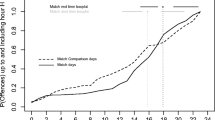Abstract
An observational tool was developed to measure guardianship potential and guardianship in action in residential areas in The Hague, the Netherlands by Reynald (Crime Prevention and Community Safety 11(1):1–20, 2009; Journal of Research in Crime and Delinquency 47(3):358–390, 2010). Guardianship potential was measured using the defensible space-based measures from the Block Environment Inventory (BEI), while Guardianship in Action (GIA) was observed by recording whether or not guardians (1) were visibly available, (2) were monitoring, and (3) intervened when necessary. This article reports on an international comparison of GIA in The Hague and in an American city. A comparative understanding will help advance knowledge on the measurement of active guardianship and related defensible space dimensions and identify socio-cultural differences in the application and meaning of the guardianship concept. Key results include that the observable dimensions of guardianship in action were reliable and valid, but some differences existed between the two sites including significant differences related to the social interaction measure. Similarities and differences across the two sites are examined, and implications for theory and research are explored.


Similar content being viewed by others
References
Armitage, R. (2000). An evaluation of Secured by design within west Yorkshire. Home Office Briefing Note 7/00. London: Home Office.
Armitage, R. (2007). Sustainability versus safety: Confusion, conflict and contradiction in designing out crime. In G. Farrell, K. J. Bowers, S. D. Johnson, & M. Townsley (Eds.), Imagination for crime prevention: Essays in honour of Ken Pease. Crime prevention studies, vol. 21 (pp. 81–110). Monsey: Criminal Justice Press.
Armitage, R., Monchuk, L., & Rogerson, M. (2011). It looks good but what is it like to live there? Exploring the impact of innovative housing design on crime. European Journal on Criminal Policy and Research, 17(1), 29–54.
Bennett, R. R. (1991). Routine activities: A cross-national assessment of a criminological perspective. Social Forces, 70(1), 147–163.
Booth, A. (1981). The built environment as a crime deterrent: A reexamination of defensible space. Criminology, 18, 557–570.
Brantingham, P. L., & Brantingham, P. J. (1993). Nodes, paths, and edges: Considerations on the complexity of crime and the physical environment. Journal of Environmental Psychology, 13, 3–28.
Brown, B. B., & Perkins, D. D. (2002). Neighborhood revitalization and disorder: An intervention evaluation: Final project report. Rockville, MD: National Criminal Justice Reference Service.
Cohen, L. E., & Felson, M. (1979). Social change and crime rate trends: A routine activity approach. American Sociological Review, 44(4), 588–608.
Cozens, P., Hillier, D., & Prescott, G. (2001). Crime and the design of residential property: Exploring the theoretical background part 1. Property Management, 19(2), 136–164.
Cozens, P., Saville, G., & Hillier, D. (2005). Crime prevention through environmental design (CPTED): A review and modern bibliography. Property Management, 23(5), 328–356.
Cozens, P. (2008). Crime prevention through environmental design. In R. Wortley & L. Mazerolle (Eds.), Environmental criminology and crime analysis. Devon: Willan.
Eck, J. E., & Weisburd, D. (1994). Crime place in crime theory. In J. E. Eck & D. Weisburd (Eds.), Crime and place. Crime prevention studies (vol. 4). Monsey: Criminal Justice Press.
Ekblom, P. (2006). Crime prevention through environmental design - time for an upgrade? Paper presented at 17th annual conference on problem-oriented policing, Madison, WI.
Ekblom, P. (2007). Crime reduction through surveillance and design. Paper presented at international crime reduction conference, Banff, Canada, October 9–11, 2007.
Ekblom, P. (2011). Deconstructing CPTED… and reconstructing it for practice, knowledge, management and research. European Journal on Criminal Policy and Research, 17(1), 7–28.
Felson, M. (1995). Those who discourage crime. In J. E. Eck & D. Weisburd (Eds.), Crime and place. Crime prevention studies, vol. 4 (1995th ed., pp. 53–66). Monsey: Criminal Justice Press.
Felson, M., & Boba, R. (2010). Crime and everyday life (4th ed.). Thousand Oaks: Sage.
Hollis-Peel, M. E., Reynald, D. M., van Bavel, M., Elffers, H., & Welsh, B. C. (2011). Guardianship for crime prevention: A critical review of the literature. Crime, Law and Social Change, 56, 53–70.
Jeffery, C. R. (1971). Crime prevention through environmental design. Beverly Hills: Sage.
Mawby, R. I. (1977). Defensible space: A theoretical and empirical appraisal. Urban Studies, 14, 169–179.
Newman, O. (1972). Defensible space: Crime prevention through urban design. New York: Collier Books.
Rengert, G. F., & Wasilchick, J. (1985). Suburban burglary: A tale of two cities. Springfield: Charles C. Thomas.
Reynald, D. M. (2009). Guardianship in action: Developing a new tool for measurement. Crime Prevention and Community Safety, 11(1), 1–20.
Reynald, D. M. (2010). Guardians on guardianship: Factors affecting the willingness to supervise, the ability to detect potential offenders, and the willingness to intervene. Journal of Research in Crime and Delinquency, 47(3), 358–390.
Reynald, D. M. (2011). Factors associated with the guardianship of places: Assessing the relative importance of the spatio-physical and socio-demographic contexts in generating opportunities for capable guardianship. Journal of Research in Crime & Delinquency, 48(1), 110–142.
Reynald, D. M. (2011). Translating CPTED into crime preventive action: A critical examination of CPTED as a tool for active guardianship. European Journal on Criminal Policy and Research, 17(1), 69–81.
Taylor, R. B., Gottfredson, S. D., & Brower, S. N. (1984). Block crime and fear: Defensible space, local social ties, and territorial functioning. Journal of Research in Crime and Delinquency, 21, 303–331.
Tseloni, A., Wittebrood, K., Farrell, G., et al. (2004). Burglary victimization in England and Wales, the United States, and the Netherlands: A cross-national comparative test of routine activities and lifestyle theories. British Journal of Criminology, 44(1), 61–91.
Welsh, B. C., Mudge, M. E., & Farrington, D. P. (2010). Reconceptualizing public area surveillance and crime prevention: Security guards, place managers, and defensible space. Security Journal, 23(4), 299–319.
Acknowledgments
We are grateful to the editor, the anonymous reviewers, and Henk Elffers for helpful comments.
Author information
Authors and Affiliations
Corresponding author
Rights and permissions
About this article
Cite this article
Hollis-Peel, M.E., Reynald, D.M. & Welsh, B.C. Guardianship and crime: an international comparative study of guardianship in action. Crime Law Soc Change 58, 1–14 (2012). https://doi.org/10.1007/s10611-012-9366-1
Published:
Issue Date:
DOI: https://doi.org/10.1007/s10611-012-9366-1




